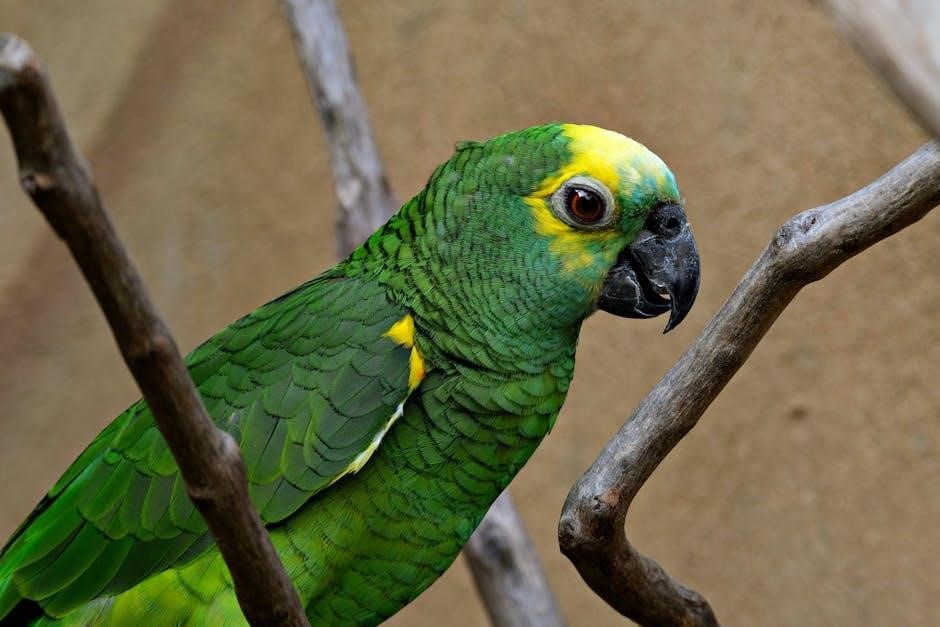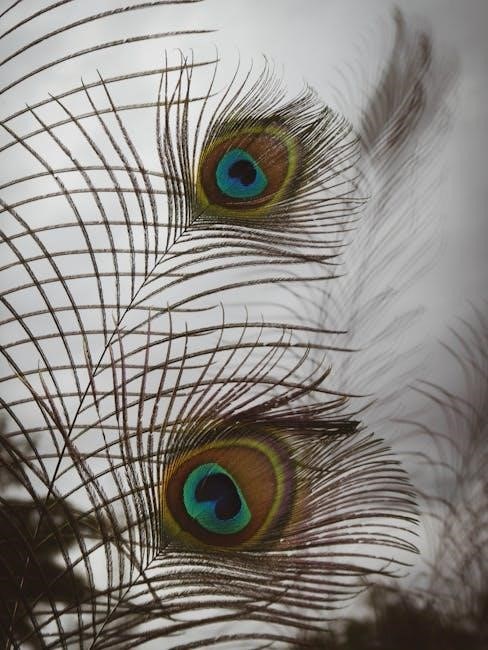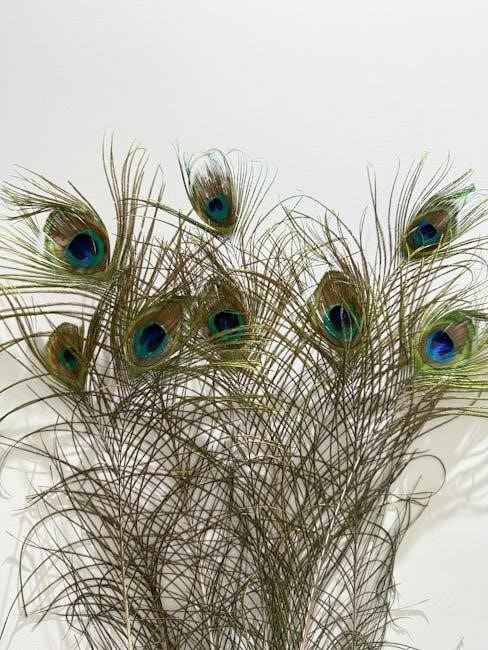Toni Morrison’s debut novel‚ The Bluest Eye‚ published in 1970‚ explores themes of beauty‚ race‚ and identity through Pecola Breedlove’s tragic desire for blue eyes in 1940s Ohio.
Overview of the Novel
Toni Morrison’s The Bluest Eye (1970) is a poignant exploration of race‚ beauty‚ and identity in 1940s America. Set in Lorain‚ Ohio‚ the novel centers on Pecola Breedlove‚ a young African American girl who yearns for blue eyes‚ symbolizing the Eurocentric beauty standards imposed on her. The story unfolds through multiple perspectives‚ including Claudia MacTeer’s narrative voice‚ offering a layered exploration of Pecola’s tragic journey. The novel critiques societal beauty ideals and the internalized racism that devastates Black communities. Divided into seasonal sections‚ it weaves together themes of innocence‚ abuse‚ and the destructive power of racial self-loathing‚ ultimately becoming a powerful commentary on America’s troubled past and its enduring impact.
Historical Context and Relevance
Toni Morrison’s The Bluest Eye is deeply rooted in the historical context of 1940s America‚ reflecting the post-Depression era’s racial tensions and societal norms. The novel critiques the pervasive Eurocentric beauty standards perpetuated during this period‚ which marginalized African Americans. Set in Lorain‚ Ohio‚ Morrison’s hometown‚ the story draws parallels to the broader Black experience in America‚ highlighting systemic racism and economic struggles. The novel’s exploration of internalized racism and its effects on individuals like Pecola Breedlove underscores the historical relevance of these themes. Morrison’s work remains a vital commentary on America’s past and its ongoing impact on contemporary issues of race and identity.

Plot Summary and Structure
The Bluest Eye unfolds through a non-linear narrative‚ divided into seasonal sections‚ exploring Pecola Breedlove’s tragic quest for blue eyes and acceptance in a racially divided society.
Seasonal Division of the Novel
The Bluest Eye is structured into four seasonal sections: Autumn‚ Winter‚ Spring‚ and Summer. Each season symbolizes a phase in Pecola Breedlove’s tragic journey. The novel begins in Autumn‚ introducing Pecola’s arrival at the MacTeers’ home‚ and progresses through Winter‚ where her struggles intensify. Spring brings devastating events‚ including Cholly’s abuse‚ while Summer concludes with Pecola’s descent into madness. The seasonal framework underscores the cyclical nature of trauma and the passage of time. This structure also mirrors the Dick and Jane primer excerpts‚ contrasting the idealized white family with the Breedloves’ fractured reality‚ emphasizing societal beauty standards and racial disparities.
Key Events and Turning Points
The novel’s pivotal moments include Pecola’s arrival at the MacTeers’ home‚ her desire for blue eyes‚ and her traumatic encounter with Cholly. These events highlight her internalized racism and suffering. Her rape by Cholly leads to pregnancy‚ while her visit to Soaphead Church results in madness. The death of her baby and her isolation symbolize societal failure‚ marking the novel’s emotional peak. These events underscore the destructive power of internalized racism and the impossibility of achieving imposed beauty standards. Morrison uses these turning points to explore the psychological and emotional devastation faced by Pecola‚ emphasizing the broader societal issues affecting African Americans.

Main Character Analysis
The novel delves into the psychological struggles of Pecola Breedlove‚ Claudia MacTeer‚ and other characters‚ exploring themes of identity‚ beauty‚ and the impact of societal oppression on their lives.
Pecola Breedlove: Her Desire and Tragedy
Pecola Breedlove‚ the central figure of The Bluest Eye‚ embodies the devastating impact of internalized racism and societal beauty standards. Her obsessive desire for blue eyes‚ symbolizing white beauty‚ reflects the destructive nature of Eurocentric ideals imposed upon African Americans. Growing up in a dysfunctional family marred by poverty and abuse‚ Pecola’s longing is a desperate attempt to escape her perceived ugliness and gain acceptance. Morrison portrays her tragic descent into madness as a result of sexual violence and betrayal‚ highlighting the broader societal failures that destroy innocence and perpetuate racial self-loathing. Pecola’s story is a heartrending critique of a world that devalues Black beauty and identity.
Claudia MacTeer: The Narrative Voice
Claudia MacTeer serves as the dual narrative voice in The Bluest Eye‚ offering both a child’s perspective and an adult’s reflection. As a young girl‚ Claudia’s hatred for white dolls and her rejection of societal beauty standards contrast sharply with Pecola’s longing for blue eyes. Her narrative provides a counterpoint to Pecola’s tragedy‚ highlighting the resilience and resistance that Claudia embodies. The adult Claudia’s hindsight adds depth‚ revealing the lasting impact of Pecola’s story while critiquing the destructive forces of racism and internalized beauty ideals. Through Claudia‚ Morrison explores themes of innocence‚ resistance‚ and the enduring scars of societal oppression. Her voice bridges past and present‚ offering a nuanced exploration of racial identity and personal growth.

Themes and Symbolism
The Bluest Eye explores the destruction of innocence through internalized racism and societal beauty ideals‚ symbolized by Pecola’s tragic pursuit of blue eyes‚ reflecting deeper racial self-loathing.
The Bluest Eye as a Symbol of Beauty Standards
Pecola’s longing for blue eyes embodies the destructive power of Eurocentric beauty ideals imposed on African Americans. Morrison uses this desire to critique societal standards that equate whiteness with beauty‚ highlighting internalized racism. The blue eyes symbolize unattainable perfection‚ reflecting Pecola’s internalized self-loathing. Through her tragic pursuit‚ Morrison exposes how these ideals devastate Black identity‚ perpetuating feelings of inadequacy. The novel underscores the broader societal issue of racialized beauty‚ showing how it fractures self-esteem and community cohesion. This haunting metaphor remains central to the novel’s exploration of race‚ identity‚ and the enduring impact of beauty standards.
Racism and Internalized Racism
The Bluest Eye vividly portrays the devastating effects of racism and internalized racism in 1940s America. Pecola Breedlove’s yearning for blue eyes symbolizes her internalization of white beauty standards‚ reflecting societal racism’s psychological toll. Morrison illustrates how systemic racism embeds self-loathing in African Americans‚ as they are conditioned to view themselves as inferior. The novel critiques a culture that equates whiteness with beauty and value‚ leading to self-rejection and fragmentation within the Black community. Through Pecola’s tragic descent‚ Morrison exposes how internalized racism perpetuates cycles of oppression‚ highlighting the urgent need for self-acceptance and resistance against dehumanizing societal norms. This theme remains central to the novel’s exploration of racial identity and resilience.
The Destruction of Innocence
The Bluest Eye poignantly explores the destruction of innocence through Pecola Breedlove’s harrowing experiences. Morrison depicts how societal racism‚ familial dysfunction‚ and sexual violence shatter Pecola’s childhood‚ leaving her psychologically scarred. The novel illustrates how innocence is lost when children are forced to confront harsh realities prematurely. Pecola’s desire for blue eyes‚ a symbol of unattainable beauty‚ underscores her vulnerability. Morrison’s narrative voice‚ often shifting between adult and child perspectives‚ emphasizes the irreversible loss of purity. Through Pecola’s tragic fate‚ the novel critiques a society that fails to protect its most vulnerable members‚ highlighting the profound consequences of allowing innocence to be destroyed. This theme resonates deeply‚ offering a powerful commentary on societal failure and human fragility.

Narrative Style and Structure
Toni Morrison’s narrative style in The Bluest Eye is non-linear and fragmented‚ using multiple perspectives‚ including Claudia’s dual voice‚ to reflect societal and familial fractures. The seasonal structure and symbolic references to Dick and Jane primers emphasize the characters’ disrupted lives.
Non-Linear Storytelling
Toni Morrison employs non-linear storytelling in The Bluest Eye‚ blending past and present through multiple narrators. This structure mirrors the fragmented lives of characters‚ particularly Pecola‚ whose tale unfolds through Claudia’s reflections and omniscient narratives. The novel begins in autumn and cycles through seasons‚ Each section revisiting events from different angles‚ creating a layered exploration of themes like race and beauty. This non-linear approach underscores the disjointedness of the characters’ experiences‚ reflecting the societal fractures they endure. Morrison’s use of flashback and foresight deepens the emotional impact‚ allowing readers to piece together Pecola’s tragedy gradually.
Multiple Narrative Perspectives
Toni Morrison enriches The Bluest Eye by utilizing multiple narrative voices‚ primarily through Claudia MacTeer‚ who narrates both as a child and an adult. This dual perspective offers insight into the events and their lasting impact. Additional voices include an omniscient narrator and minor characters‚ providing diverse viewpoints that expand the novel’s depth. These shifting perspectives allow Morrison to explore themes like internalized racism and beauty standards from various angles‚ creating a multifaceted narrative. The interplay of voices highlights the complexity of societal influences on individual lives‚ adding layers to the story’s emotional and psychological resonance.

Supporting Characters
The novel’s supporting characters‚ including Cholly Breedlove‚ Pauline Breedlove‚ and Maureen Peal‚ play pivotal roles in shaping Pecola’s tragic narrative and exploring themes of beauty and race.
Cholly Breedlove: Pecola’s Father
Cholly Breedlove‚ Pecola’s father‚ is a complex and troubled figure‚ shaped by a life of poverty‚ abandonment‚ and internalized racism. His relationship with Pecola is marked by both tenderness and violence‚ culminating in a tragic act of incest that devastates her. Cholly’s backstory reveals a man deeply scarred by his upbringing and societal oppression‚ which erodes his ability to provide love and stability. His actions‚ though horrific‚ are portrayed as a consequence of generations of racial and economic marginalization. Morrison humanizes Cholly‚ making him a symbol of the cyclical destruction caused by systemic injustice. His character underscores the novel’s exploration of broken identities and the long-lasting impact of trauma.
Pauline Breedlove: Pecola’s Mother
Pauline Breedlove‚ Pecola’s mother‚ is a deeply flawed and emotionally distant figure‚ consumed by her own bitterness and unfulfilled dreams. Her fixation on her disabled foot and her escape into Hollywood fantasies reflect her internalized racism and dissatisfaction with her life. Pauline’s neglect of Pecola stems from her inability to love herself‚ projecting her self-hatred onto her daughter. Her relationship with her family is strained‚ particularly with her husband Cholly‚ as their mutual resentment and despair create a toxic home environment. Morrison portrays Pauline as a product of societal oppression‚ highlighting how systemic racism and poverty distort individual identities and familial bonds. Her character exemplifies the destructive cycle of self-loathing and abandonment.
Maureen Peal: The Symbol of Rivalry
Maureen Peal‚ a light-skinned African American girl‚ represents societal beauty ideals and class rivalry in The Bluest Eye. Her character symbolizes the internalized racism and competition among African Americans‚ as her light skin grants her social acceptance. Initially friendly with Pecola‚ Maureen later humiliates her‚ declaring herself “cute” and Pecola “ugly‚” deepening Pecola’s self-loathing. Maureen’s character highlights the destructive effects of beauty standards and racial hierarchies‚ emphasizing how societal preferences for light skin perpetuate division and self-hatred within the African American community. Morrison uses Maureen to critique the ways in which external beauty ideals distort self-perception and relationships. Her presence underscores the novel’s exploration of identity and race.

Setting and Background
The Bluest Eye is set in Lorain‚ Ohio‚ during the 1940s‚ reflecting the racial and economic disparities of the time. The Breedlove family’s impoverished living conditions underscore the novel’s exploration of societal oppression and internalized racism‚ shaping the characters’ experiences and struggles.
Lorain‚ Ohio in the 1940s
Lorain‚ Ohio‚ in the 1940s serves as the backdrop for The Bluest Eye‚ a town marked by racial and economic disparities. Morrison’s hometown reflects the era’s segregation‚ with black neighborhoods on the west side and industrial areas dominating the landscape. The Breedlove family’s impoverished living conditions highlight the town’s neglect of African American communities. The seasonal structure of the novel mirrors Lorain’s changing environment‚ from the chill of autumn to the warmth of summer‚ each season influencing the characters’ experiences. The setting underscores the societal oppression and internalized racism that shape Pecola’s tragic journey‚ embedding the novel’s themes deeply within its Midwestern context.
The Breedlove Family’s Living Conditions
The Breedlove family resides in a decrepit‚ rented house in Lorain‚ reflecting their economic and emotional poverty; Their home‚ described as “ugly” and “temporary‚” lacks stability and warmth‚ mirroring their fractured relationships. Cholly’s destructive tendencies‚ including burning down their previous house‚ further destabilize their living situation. The family’s constant displacement and squalid environment exacerbate Pecola’s feelings of worthlessness. Pauline’s meticulous care of her employer’s home contrasts with her neglect of her own‚ highlighting internalized racism and self-loathing. Their living conditions symbolize the broader societal neglect of African Americans‚ reinforcing the novel’s critique of racial and economic oppression. Morrison’s vivid portrayal underscores the harsh realities shaping the Breedloves’ lives.

Impact and Reception
The Bluest Eye initially received limited attention but later gained recognition as a powerful exploration of racism‚ beauty standards‚ and trauma. It became a cultural landmark‚ sparking crucial conversations about identity and societal norms‚ solidifying Morrison’s legacy as a literary icon.
Initial Reception and Later Recognition
The Bluest Eye was initially met with mixed reviews and limited commercial success upon its release in 1970. Many critics struggled with its unflinching portrayal of racism‚ incest‚ and poverty. However‚ the novel gradually gained recognition for its profound exploration of internalized racism and the destructive nature of societal beauty standards. Over time‚ it became a cornerstone of African American literature‚ earning Morrison widespread acclaim. By the 1980s‚ it was widely studied in universities‚ and its reputation as a masterpiece solidified. Morrison’s eventual Nobel Prize in 1993 further cemented the novel’s status as a vital work in American literary history.
Cultural and Social Significance
The Bluest Eye holds profound cultural and social significance as a powerful critique of Eurocentric beauty standards and systemic racism. Morrison’s unflinching portrayal of Pecola’s tragic quest for blue eyes exposes the internalized racism faced by African Americans. The novel challenges societal norms that equate whiteness with beauty and value‚ offering a searing indictment of a culture that marginalizes Black identity. Its exploration of themes like childhood trauma‚ poverty‚ and gender dynamics resonates deeply‚ making it a pivotal work in understanding the African American experience. The novel’s impact extends beyond literature‚ influencing conversations on race‚ identity‚ and social justice in broader cultural contexts.

Analysis and Criticism
The Bluest Eye has been critically acclaimed for its profound exploration of internalized racism‚ gender oppression‚ and societal beauty standards. Morrison’s vivid portrayal of trauma and psychological damage has been praised for its unflinching honesty‚ offering deep insights into the human condition and the destructive power of societal norms. Critics highlight its nuanced narrative structure and its ability to evoke empathy while challenging readers to confront uncomfortable truths about race and identity. The novel remains a cornerstone of literary analysis‚ particularly through feminist and Marxist lenses‚ for its bold critique of systemic oppression. Morrison’s masterpiece continues to resonate‚ sparking essential conversations about humanity’s darker complexities. The text’s exploration of innocence’s destruction and the enduring impact of childhood experiences further solidifies its place in critical discourse.
Feminist and Marxist Perspectives
Feminist critics highlight Morrison’s portrayal of women’s oppression‚ particularly Black women‚ under patriarchal and racist systems. Pecola’s desire for blue eyes symbolizes internalized racism and the destruction of self-worth. The novel critiques societal beauty standards that devalue Black features‚ reflecting broader feminist concerns about objectification and identity. Marxist interpretations emphasize economic oppression‚ with the Breedlove family’s poverty mirroring systemic inequality. Cholly’s emasculation and Pauline’s resignation illustrate how capitalism exacerbates racial and gendered exploitation. Both perspectives intersect in the novel’s exploration of how race‚ class‚ and gender intertwine to perpetuate oppression‚ offering a scathing critique of power structures and their impact on marginalized communities.
Psychological Insights into Characters
The novel offers profound psychological insights into its characters‚ revealing the emotional scars of racism and trauma. Pecola’s obsession with blue eyes stems from internalized racism and a desperate quest for validation. Cholly’s violent behavior is rooted in childhood trauma and feelings of powerlessness‚ while Pauline’s emotional detachment reflects her resignation to a life of oppression. Claudia’s narrative voice provides a contrasting perspective‚ showcasing her resilience and defiance against societal norms. Morrison’s exploration of these characters’ inner lives exposes the psychological toll of systemic racism and the fragility of the human spirit in the face of relentless oppression and societal expectations.

Resources and Editions
The Bluest Eye is available in multiple editions‚ including paperback and e-book formats. ISBN-10: 0452287065‚ ISBN-13: 9780452287068. Study guides and critical essays offer deeper analysis for scholars and readers alike.
Published Editions and Covers
Toni Morrison’s The Bluest Eye has been published in various editions since its debut in 1970. The first edition featured a striking cover designed by Herb Lubalin and Jay Me.Over the years‚ the novel has been released in paperback‚ hardcover‚ and e-book formats‚ each with distinct cover art reflecting its themes. The 2005 paperback edition‚ with ISBN-10: 0452287065 and ISBN-13: 9780452287068‚ remains widely popular. These editions ensure the novel’s accessibility‚ allowing readers to engage with its powerful narrative in multiple formats‚ thus preserving its cultural and literary significance for future generations.
Study Guides and Critical Essays
Study guides and critical essays on The Bluest Eye provide in-depth analyses of its themes‚ characters‚ and historical context. Resources like MEG guides offer summaries‚ character breakdowns‚ and discussion questions‚ aiding readers in understanding the novel’s complexity. Critical essays explore perspectives such as Marxist and feminist interpretations‚ examining themes like internalized racism and beauty standards. These resources also highlight Morrison’s narrative techniques‚ such as non-linear storytelling and multiple perspectives. Online platforms and academic articles further delve into the novel’s psychological insights and cultural significance. Together‚ these tools enrich readers’ engagement with Morrison’s groundbreaking work‚ making it accessible for both academic and casual readers to explore its profound themes.
The Bluest Eye remains a powerful exploration of beauty‚ race‚ and identity‚ cementing Toni Morrison’s legacy as a vital voice in American literature and cultural critique.
Legacy of “The Bluest Eye”
Toni Morrison’s The Bluest Eye has left an indelible mark on American literature‚ becoming a cornerstone of discussions on race‚ beauty‚ and identity. Despite its initial lack of recognition‚ the novel has evolved into a classic‚ celebrated for its poignant portrayal of the African American experience. Morrison’s exploration of internalized racism and the destructive nature of Eurocentric beauty standards continues to resonate deeply. The novel’s legacy is further cemented by its inclusion in academic curricula worldwide‚ ensuring its themes remain relevant in contemporary conversations about social justice and equality. Morrison’s Nobel Prize in 1993 solidified her influence‚ making The Bluest Eye a timeless work of profound cultural significance.
Final Thoughts on the Novel’s Importance
The Bluest Eye stands as a powerful critique of societal beauty standards and racial injustice‚ offering a haunting reflection of America’s past. Its unflinching narrative sheds light on the psychological toll of internalized racism and the fragility of childhood innocence. Morrison’s masterful storytelling challenges readers to confront uncomfortable truths‚ making the novel a vital piece of American literature. Its exploration of themes such as identity‚ family dysfunction‚ and societal oppression ensures its relevance today‚ fostering empathy and understanding. Ultimately‚ The Bluest Eye remains a crucial work for discussions on race‚ gender‚ and the enduring impact of historical trauma‚ cementing its place in literary history.
